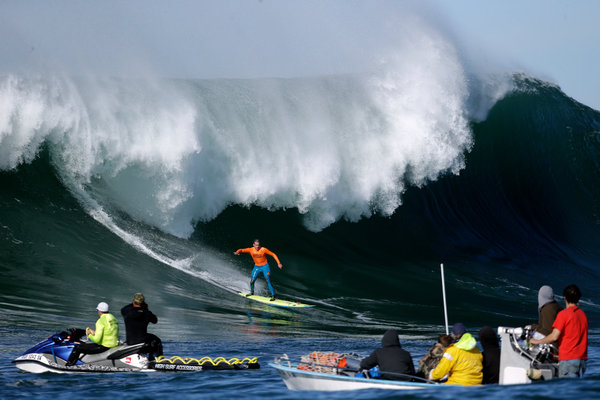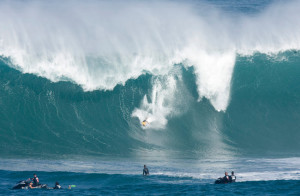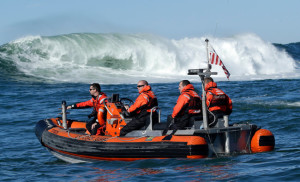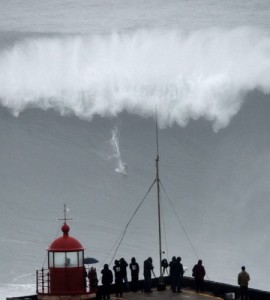VIA – NY TIMES
Mavericks is a famous break in California. The big-wave surfers Kohl Christensen and Danilo Couto started the Big Wave Safety Summit in 2011 to honor Sion Milosky, who died at Mavericks.
By TALYA MINSBERG
Published: December 4, 2013
Surfers around the world descend every winter on the North Shore of Oahu, where a five-mile stretch of breaks churns out picturesque waves with inconceivable power.
But last month, the tight-knit big-wave community, a group that surfs waves taller than 20 feet, was reminded of the beast behind the beauty of the coast’s surf breaks. Kirk Passmore, a resident of Hawaii and a big-wave surfer, took off on a wave at an outer break called Alligator Rock. He went down in a brutal wipeout and was never seen again.
His final wave was captured by a cinematographer, Larry Haynes, and at the request of Passmore’s father, it has been made public and has since been widely viewed. Passmore disappeared a week before the 2013 Big Wave Safety Summit, held just a few miles down the road at the Turtle Bay Resort. The gathering, now in its third year, advises surfers on the newest strategies and equipment for improving safety in a dangerous sport.
But Passmore’s death made this year’s gathering especially poignant.
“Every time you suffer a loss — it doesn’t matter who it is — for a moment, we all take a step back, and we question, ‘Is this the right thing?’ ” said Archie Kalepa, a lifeguard and a well-known Hawaii surfer.
The meeting is held on the North Shore, home to some of the sport’s most prestigious contests, including the Vans Triple Crown of Surfing and the Quiksilver in Memory of Eddie Aikau. The sessions take place during holding periods, as event coordinators wait for world-class waves suited for world-class athletes.
The safety meeting was started in 2011 by Kohl Christensen and Danilo Couto, two big-wave surfers, as a way to honor Sion Milosky, who died while surfing Mavericks, a famous break in Northern California. Milosky’s death shook Christensen and Couto, each of whom has had several friends who died in the sport.
Eugene Tanner/Associated Press
A surfing competition on the North Shore of Oahu in 2009. Big-wave surfers have begun organizing annual safety programs in conjunction with such events.
The first session was held in Christensen’s barn. The event has grown into a two-day course held at Turtle Bay, a resort, and attended by about 80 big-wave riders from around the world. Christensen has received several requests to hold similar safety sessions at popular surfing spots around the globe.
The course focuses on the importance of communication strategies in worst-case situations, as well as new safety tools, such as inflatable vests.
The stereotype of surfers as “absent-minded dudes is way, way past its history,” said Mike Slattery, a big-wave surfer and the owner of High Surf Accessories, an outfitter specializing in personal watercraft and safety equipment.
“It’s 2013,” Slattery said, “and anybody would be foolish to not use all the resources available at their disposal.”
Slattery was among the first people to sell rescue equipment for surfers in the 1990s. “It started out purely as a necessity and grew to a very low undercurrent of demand and interest,” he said. “People are using common sense with technology now — it’s not impulsive; people are creating plans.”
Surfing is inherently dangerous; there is no way to remove the risk entirely from a sport that involves flying down an 80-foot wave, skimming atop sharp reefs or swimming in shark-infested waters. And while surfers have long been drawn to isolated spots, the one-upmanship has only increased in recent years as surfers look for waves in locations far from lifeguards or hospitals. All of that means that safety concerns are more vital than ever, according to surfing experts.
Marcio Jose Sanchez/Associated Press
Coast Guard personnel at a competition at Mavericks, in California. A surfer’s death there prompted the safety meetings.
Surf companies have turned their attention to improving safety on the waves as well. Billabong and Patagonia have recently introduced new products like inflatable life vests.
If many surfers once saw themselves as too cool to wear safety gear, that attitude is “pretty much extinct,” said Dk Walsh, a big-wave surfer in Hawaii.
“You’re not cool and you are definitely not smart if you’re not focusing on equipment,” Walsh said. “No one shows up to Jaws or Mavericks or the biggest waves in the world with just a surfboard. People would look down upon you.”
At the safety meeting, Brian Keaulana, a well-known surfer and safety instructor, commanded the full attention of novices and seasoned veterans. He urged the group to work together to create a measure of safety among the world’s most dangerous waves.
“Being a great surfer is easy,” he said. “Surviving is hard.”
On the second day of the course, the surfers hit the water to practice their new safety skills, taking turns attempting rescues and administering cardiopulmonary resuscitation. Most participants said that the safety skills they had learned were more important than ever — and that they needed to learn to work together in what can sometimes be seen as an individual sport.
Francisco Leong/Agence France-Presse — Getty Images
Surfers who seek out mammoth breakers around the world take big risks, but they are trying to focus more on safety.
“These guys are chasing down and riding waves that were cartoonish, unimaginable, and now they are real,” said Jodi Wilmott, a big-wave event organizer. “After being present for those two days, I think those guys truly believe this is a team sport, and they didn’t have that before.”
 Become A Sponsor!
Become A Sponsor!If you have a product or service that is a good fit for our surf community, we have opportunities for you to sponsor this blog! Download our media kit now!




